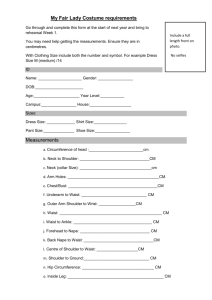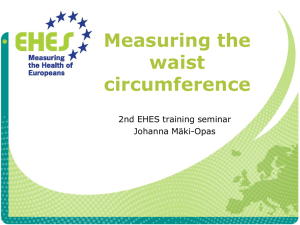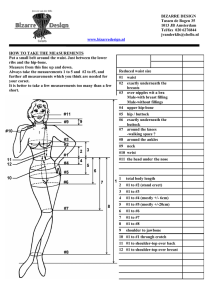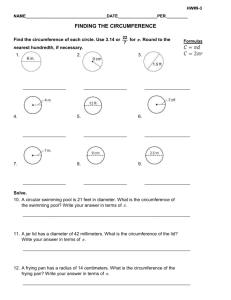Science Journal of Medicine and Clinical Trials ISSN:2276-7487
advertisement
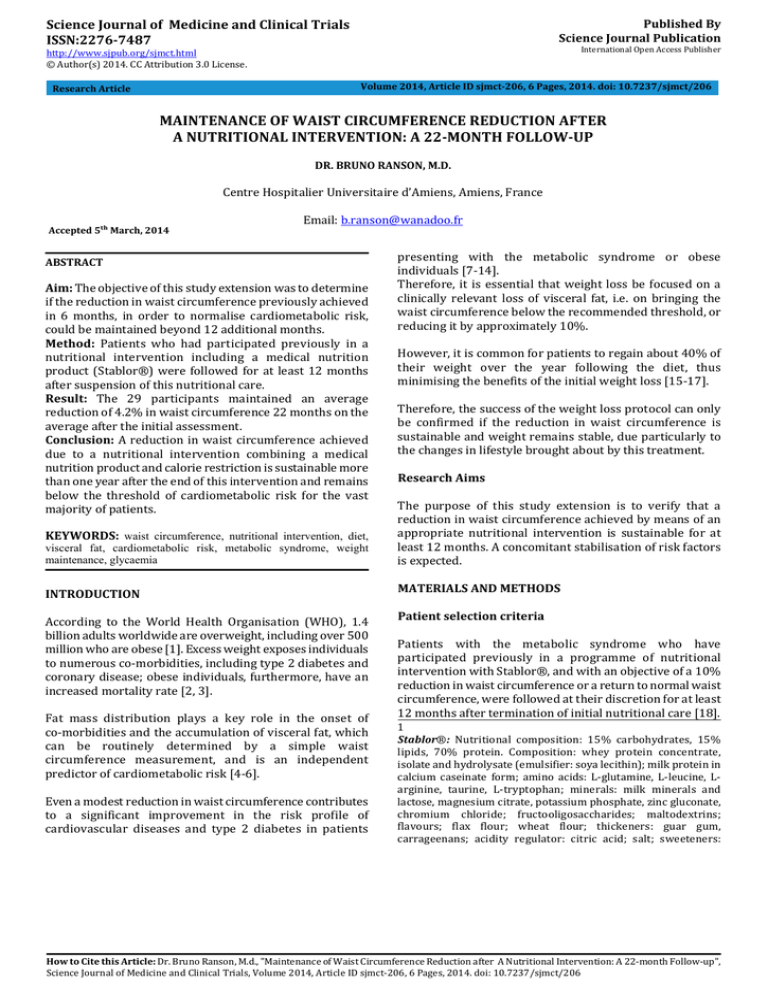
Published By Science Journal Publication Science Journal of Medicine and Clinical Trials ISSN:2276-7487 International Open Access Publisher http://www.sjpub.org/sjmct.html © Author(s) 2014. CC Attribution 3.0 License. Volume 2014, Article ID sjmct-206, 6 Pages, 2014. doi: 10.7237/sjmct/206 Research Article MAINTENANCE OF WAIST CIRCUMFERENCE REDUCTION AFTER A NUTRITIONAL INTERVENTION: A 22-MONTH FOLLOW-UP DR. BRUNO RANSON, M.D. Centre Hospitalier Universitaire d’Amiens, Amiens, France Accepted 5�� March, 2014 Email: b.ranson@wanadoo.fr ABSTRACT Aim: The objective of this study extension was to determine if the reduction in waist circumference previously achieved in 6 months, in order to normalise cardiometabolic risk, could be maintained beyond 12 additional months. Method: Patients who had participated previously in a nutritional intervention including a medical nutrition product (Stablor®) were followed for at least 12 months after suspension of this nutritional care. Result: The 29 participants maintained an average reduction of 4.2% in waist circumference 22 months on the average after the initial assessment. Conclusion: A reduction in waist circumference achieved due to a nutritional intervention combining a medical nutrition product and calorie restriction is sustainable more than one year after the end of this intervention and remains below the threshold of cardiometabolic risk for the vast majority of patients. KEYWORDS: waist circumference, nutritional intervention, diet, visceral fat, cardiometabolic risk, metabolic syndrome, weight maintenance, glycaemia presenting with the metabolic syndrome or obese individuals [7-14]. Therefore, it is essential that weight loss be focused on a clinically relevant loss of visceral fat, i.e. on bringing the waist circumference below the recommended threshold, or reducing it by approximately 10%. However, it is common for patients to regain about 40% of their weight over the year following the diet, thus minimising the benefits of the initial weight loss [15-17]. Therefore, the success of the weight loss protocol can only be confirmed if the reduction in waist circumference is sustainable and weight remains stable, due particularly to the changes in lifestyle brought about by this treatment. Research Aims The purpose of this study extension is to verify that a reduction in waist circumference achieved by means of an appropriate nutritional intervention is sustainable for at least 12 months. A concomitant stabilisation of risk factors is expected. INTRODUCTION MATERIALS AND METHODS According to the World Health Organisation (WHO), 1.4 billion adults worldwide are overweight, including over 500 million who are obese [1]. Excess weight exposes individuals to numerous co-morbidities, including type 2 diabetes and coronary disease; obese individuals, furthermore, have an increased mortality rate [2, 3]. Patient selection criteria Fat mass distribution plays a key role in the onset of co-morbidities and the accumulation of visceral fat, which can be routinely determined by a simple waist circumference measurement, and is an independent predictor of cardiometabolic risk [4-6]. Even a modest reduction in waist circumference contributes to a significant improvement in the risk profile of cardiovascular diseases and type 2 diabetes in patients Patients with the metabolic syndrome who have participated previously in a programme of nutritional intervention with Stablor®, and with an objective of a 10% reduction in waist circumference or a return to normal waist circumference, were followed at their discretion for at least 12 months after termination of initial nutritional care [18]. 1 Stablor®: Nutritional composition: 15% carbohydrates, 15% lipids, 70% protein. Composition: whey protein concentrate, isolate and hydrolysate (emulsifier: soya lecithin); milk protein in calcium caseinate form; amino acids: L-glutamine, L-leucine, Larginine, taurine, L-tryptophan; minerals: milk minerals and lactose, magnesium citrate, potassium phosphate, zinc gluconate, chromium chloride; fructooligosaccharides; maltodextrins; flavours; flax flour; wheat flour; thickeners: guar gum, carrageenans; acidity regulator: citric acid; salt; sweeteners: How to Cite this Article: Dr. Bruno Ranson, M.d., "Maintenance of Waist Circumference Reduction after A Nutritional Intervention: A 22-month Follow-up", Science Journal of Medicine and Clinical Trials, Volume 2014, Article ID sjmct-206, 6 Pages, 2014. doi: 10.7237/sjmct/206 Science Journal of Medicine and Clinical Trials( ISSN:2276-7487) potassium acesulfame, sucralose; vitamins: D, B6, B9, E; colour: riboflavin; natural rosemary extract. Study programme Patients were monitored during outpatient nutrition consultations. All patients had followed the first part of the study that consisted of intensive nutritional care, including a balanced diet (50% carbohydrates, 35% lipids, 15% proteins; carbohydrates with glycaemic load less than 10), low-calorie (700 kcal restriction on base metabolism, accompanied by a whey-based medical nutrition product taken twice daily (Stablor®) and contributing 360 kcal to the daily ration. Patients were called in for a new assessment about 16 months after this weight loss phase, which had an average duration of 6 months. In the interval, patients were not following any particular treatment, but were encouraged to maintain a balanced diet without calorie restriction, and moderate physical activity equivalent to 5,000 steps per week. (Table 1). RESULTS Description of the Population In total, 29 (45%) of the 64 patients who had participated in the initial study consisting of intensive nutritional care were included in the study extension. The characteristics of the population included for intensive nutritional care are described in Table 2. It should be noted that patients who participated in the study extension differed from those who completed the intensive phase by their smaller waist circumference (92.6 cm versus 94.2 cm) and a lower BMI in men, with a difference of over one point. Effects on waist circumference Amongst the 29 patients who took part in this follow-up, the vast majority (27/29) maintained their waist circumference below the initial level. The average decrease of waist circumference over the entire 22-month follow-up period was 4 cm (4.2%); one-third of patients (9/29) maintained a 5% decrease in waist circumference. (Figure 1). Secondary outcome measures Weight loss (Table 3): weight loss was on the same order of magnitude as waist circumference reduction, i.e. 4.9 kg. This loss was mainly due to a reduction of fat mass (4.2 kg). Blood pressure: this parameter remained within normal standards in one-half of 14 hypertensive subjects at inclusion, more than one year after the weight loss phase, in spite of a slight increase in systolic blood pressure. Biological parameters: all evolved favourably. Blood glucose profile: The fasting blood glucose levels of 9 out of 11 hyperglycaemic and non-diabetic patients remained within normal standards at the end of the study extension. None of the 16 normoglycaemic patients developed impaired fasting glucose (IFG). page 2 at the end of the weight loss phase remained within normal standards after the follow-up months. Lipid profile: no patient developed lipid abnormalities Tolerance No adverse events were spontaneously reported. During follow-up visits, patients were questioned about the onset of adverse event since their last visit. , DISCUSSION A balanced low-calorie diet, supplemented twice daily with Stablor® resulted in a reduction in waist circumference of nearly 10% after 6 weeks on average. This reduction in waist circumference was associated with a weight loss due mainly to a loss of fat mass and a favourable evolution of the cardiometabolic risk profile [18]. Sixteen (16) months later, the vast majority of patients maintained a sharply diminished waist circumference and weight compared to initial values; most of the weight loss was due to a loss of fat mass. No worsening of, and even improvement, in their biological parameters was noted. Over nearly 2 years of follow-up, weight loss was almost exclusively due to loss of fat mass, which may explain the concomitant results for biological parameters and particularly for blood glucose, inflammatory markers, and high blood pressure. Stablor® appears, in fact, to have had a particularly notable effect on the blood glucose profile, CRPus and blood pressure. The long-term maintenance phase also showed that no patient developed IFG and that two-thirds of hyperglycaemic or diabetic patients at inclusion were standardised at the end of follow-up. In spite of a slight increase in systolic blood pressure after stopping Stablor®, one-half of hypertensive patients at inclusion remained within normal standards at the end of the extension phase. Fourteen (14) additional patients received comparable nutritional care including Stablor® for 6 months and followup for at least 12 months. An analysis grouping initial patients (29) and additional patients (14) showed the same evolution as the first patient group, i.e. a sustainable decrease in waist circumference (Figure 2) and loss of weight, due mainly to a loss of fat mass at 20 months on average. A similar evolution of biological parameters with an effect on the blood glucose and inflammatory profiles more than one year after stopping the weight loss phase was observed: once again, no worsening was noted and the majority of patients returned to normoglycaemia. Annual visits providing a follow-up for a total of 5 years are planned. This follow-up will show the evolution of waist circumference and risk factors, even if only complete epidemiological studies are able to estimate the effect of nutritional care with Stablor® and the resulting changes in lifestyle, for the improvement of risk factors or for the onset of diseases such as diabetes. CONCLUSION Inflammation markers: the 5 patients with non-standard CRPus levels at inclusion that had returned to normal values This open study shows that a reduction in waist circumference achieved due to a nutritional intervention How to Cite this Article: Dr. Bruno Ranson, M.d., "Maintenance of Waist Circumference Reduction after A Nutritional Intervention: A 22-month Follow-up", Science Journal of Medicine and Clinical Trials, Volume 2014, Article ID sjmct-206, 6 Pages, 2014. doi: 10.7237/sjmct/206 page 3 Science Journal of Medicine and Clinical Trials( ISSN:2276-7487) combining a medical nutrition product and calorie restriction is sustainable more than one year after the end of the intervention. The residual effect of this reduction in waist circumference 16 months on average after stopping nutritional care can be observed in all cardiometabolic risk factors. As no normoglycaemic patient at inclusion developed fasting hyperglycaemia almost two years after the start of the study, and as the majority of patients who were initially hyperglycaemic remain standardised, this study warrants further exploration of preventive care of pre-diabetic patients with Stablor®. This study also shows the sensitivity of high blood pressure with reduction in waist circumference under Stablor® and also with the recovery of this waist circumference. Additional randomised and controlled studies on large numbers of subjects should specify the specific role of Stablor® in the control of inflammation factors and the blood glucose profile, and even its impact on the prevention of diabetes or glucose intolerance. Furthermore, current investigation of the effects of whey bioactive peptides could be used to better characterise the action of Stablor®. the metabolic syndrome according to recent definitions. Diabetes Care. 2007 Sep; 30(9): 2381-7. Epub 2007 Jun 11 4. Pischon T, Boeing H, Hoffmann K, Bergmann M, et al. General and abdominal adiposity and risk of death in Europe. N Engl J Med. 2008 Nov 13; 359(20): 2105-20. 5. Dallongeville J et al. Abdominal obesity is associated with ineffective control of cardiovascular risk factors in primary care in France. Diabetes & Metabolism, 2008; 34: 606-11. 6. Cormier MA, Deprés JP, Davis N, et al. Assessing adiposity: a scientific statement from the American Heart Association. Circulation. 2011 Nov 1; 124(18): 1996-2019. 7. Klein S, Allison DB, Heymsfield SB, Kelley DE, Leibel RL, Nonas C, Kahn R; Association for Weight Management and Obesity Prevention; NAASO; Obesity Society; American Society for Nutrition; American Diabetes Association. Waist circumference and cardiometabolic risk: a consensus statement from shaping America's health: Association for Weight Management and Obesity Prevention; NAASO, the Obesity Society; the American Society for Nutrition; and the American Diabetes Association. Diabetes Care. 2007 Jun; 30(6): 1647-52. 8. Ishizaka N. Association between changes in waist circumference versus in body mass index and changes in cardiometabolic risk factors. Ningen Dock 2011; 25:1-5. 9. Balkau B, Picard P, Vol S, Fezeu L, Eschwège E; DESIR Study Group. Consequences of change in waist circumference on cardiometabolic risk factors over 9 years: Data from an Epidemiological Study on the Insulin Resistance Syndrome (DESIR). Diabetes Care. 2007 Jul;30(7):1901-3 Abbreviations BMI Body Mass Index BMR Basal Metabolic rate CRPus Ultra-sensitive C-reactive Protein HDL High-Density Lipoprotein IDF International Diabetes Federation IFG Impaired Fasting Glucose LDL Low-Density Lipoprotein SD Standard deviation Acknowledgment This study was entirely funded by Laboratoires Nutrition et Cardiométabolisme (Bordeaux, France), a Research and Development company, owner of Stablor® patent. Statement of Competing Interests The author has no competing interests. REFERENCES 1. World Health Organization. Fact file on obesity and overweight. Reviewed March 2013 2. Després JP, Lemieux I, Bergeron J, Pibarot P, Mathieu P, Larose E, Rodés‑Cabau J, Bertrand OF, Poirier P. Abdominal obesity and the metabolic syndrome: contribution to global cardiometabolic risk. Arterioscler Thromb Vasc Biol. 2008 Jun; 28(6): 1039-49. Epub 2008 Mar 20. Review. Erratum in: Arterioscler Thromb Vasc Biol. 2008 Jul; 28(7): e151 3. Guize L, Thomas F, Pannier B, Bean K, Jego B, Benetos A. All-cause mortality associated with specific combinations of 10. Pataky Z, Bobbioni-Harsch E, Golay A. Cardio-metabolic profile is influenced by modest modifications of body weight. Rev Med Suisse. 2012 Mar 28; 8(334):670-2. 11. Katsoulis K, Blaudeau TE, Roy JP, Hunter GR. Diet-induced changes in intra-abdominal adipose tissue and CVD risk in American women. Obesity. 2009 Dec; 17(12):2169-75. 12. Lovegrove JA, Griffin BA. Can dietary modification reduce the cardiovascular complications of metabolic syndrome? 'All for one' or 'one for all'? Expert Rev Cardiovasc Ther. 2011 Apr; 9(4):413-6. 13. Lissner L, Odell PM, D'Agostino RB, Stokes J 3rd, Kreger BE, Belanger AJ, et al. Variability of body weight and health outcomes in the Framingham population. N Engl J Med 1991; 324:1839-44 14. IDF. The IDF consensus. Worldwide definition of the metabolic syndrome. 2005 15. Wadden TA, Webb VL, Moran CH, Bailer BA. Lifestyle modification for obesity: new developments in diet, physical activity, and behavior therapy. Circulation 2012;125: 11571170. 16. Olson MB, Kelsey SF, Bittner V, Reis SE, Reichek N, Handberg EM, et al. Weight cycling and High-density Lipoprotein cholesterol in women: Evidence of an adverse effect. J Am Coll Cardiol 2000; 36:1565-71. 17. Jeffery RW. Does weight cycling present a health risk? Am J Clin Nutr. 1996 Mar;63(3 Suppl):452S-455S. 18. Dr. Bruno Ranson, M.D "Impact of a Nutritional Intervention on Waist Circumference Reduction" Science Journal of Medicine & Clinical Trials, Volume 2013, Article ID sjmct-263, How to Cite this Article: Dr. Bruno Ranson, M.d., "Maintenance of Waist Circumference Reduction after A Nutritional Intervention: A 22-month Follow-up", Science Journal of Medicine and Clinical Trials, Volume 2014, Article ID sjmct-206, 6 Pages, 2014. doi: 10.7237/sjmct/206 Science Journal of Medicine and Clinical Trials( ISSN:2276-7487) Page 4 FIGURES AND TABLES Fig 1. Changes to waist circumference during the study (N=29) Figure 2. Changes to waist circumference (pooled analysis grouping initial (29) and additional patients (14) - N=43) How to Cite this Article: Dr. Bruno Ranson, M.d., "Maintenance of Waist Circumference Reduction after A Nutritional Intervention: A 22-month Follow-up", Science Journal of Medicine and Clinical Trials, Volume 2014, Article ID sjmct-206, 6 Pages, 2014. doi: 10.7237/sjmct/206 page 5 Science Journal of Medicine and Clinical Trials( ISSN:2276-7487) Table 1. Study assessments Initial visit Informed consent signed Motivations, weight loss history, smoking, current medication, family history of cardiovascular events, height Clinical examination, weight, waist circumference, BMI Lean mass, fat mass (impedance measurement) Diastolic and systolic blood pressure Biological profile: - Inflammation and coagulation markers: CRPus; fibrinogen - Lipid profile: triglycerides, total cholesterol, HDL cholesterol and calculated LDL cholesterol -Glycaemic profile: fasting blood glucose Adverse events collection x Start of study extension / End of the intensive nutritional intervention phase x End of the Study extension x x x x x x x x x x x x x x x Table 2. Baseline characteristics of patients who participated in the study extension (N=29) and patients who completed the initial intensive nutritional phase Mean age (years) Waist circumference (cm) Height (cm) Weight (kg) BMI (kg/m²) with BMI<25 with BMI>25 including obese subjects ((BMI> 30) BMR, basal metabolism rate (kcal) Co-morbidities Diabetes Sleep apnoea Concomitant treatment: Central antihypertensive Diuretic Oral antidiabetic Smokers Family history Previous diet Patients who participated in the study extension (mean ± SD, or number of patients) N=29 Men Women 8 21 58.6±8.2 55.5 ± 8.4 Patients who completed the initial intensive nutritional phase (mean ± SD, or number of patients) N=64 Men Women 15 49 53.7±11.1 53.0 ±11.0 98.0±5.4 90.5±10.8 101.9±7.3 91.9±10.2 177.3±4.3 87.4±4.0 27.8±1.4 0 8 163.1± 6.6 73.0±13.2 27.6±6.1 7 14 177.8±4.9 92.3±8.6 29.2±2.6 0 15 163.6±6.1 74.3±11.5 27.8±4.9 13 36 1 3 4 11 1719±163 1349±102 1745±272 1367±110 1 0 1 0 1 0 2 1 1 0 1 0 4 1 3 0 1 1 7 16 2 1 1 1 8 1 4 0 2 2 18 39 How to Cite this Article: Dr. Bruno Ranson, M.d., "Maintenance of Waist Circumference Reduction after A Nutritional Intervention: A 22-month Follow-up", Science Journal of Medicine and Clinical Trials, Volume 2014, Article ID sjmct-206, 6 Pages, 2014. doi: 10.7237/sjmct/206 Science Journal of Medicine and Clinical Trials( ISSN:2276-7487) Page 6 Table 3. Results for the 29 patients who participated to study extension Initial value (mean ± SD Final value Change (mean ± SD) % change 92.6±10.1 88.6±9.8 -4.0±4.7 -4.2 77.0±13.1 72.1±13.1 -4.9±4.3 -6.4 BMI (kg/m²) 27.7±5.2 25.9±5.0 -1.8±1.6 -6.4 Fat mass (kg) 26.4±8.0 22.3±7.5 -4.2±3.6 -16.1 Lean mass (kg) 50.6± 9.8 49.8 ±9.8 -0.8 ±2.5 -1.4 Fat mass (%) Systolic blood pressure (mmHg) Diastolic BP (mmHg) T. Cholesterol (mmol/l) HDL (mmol/l) 34.3± 6.5 30.7± 6.9 -3.6±3.3 -10.5 128.3±15.5 130.7±9.4 2.4±16.2 3·0 80.0±10.0 70.1±6.2 -9.9±11.1 -11.2 5.80±0.87 5.58±0.77 -0.22±0.29 -3.5 1.54±0.45 1.52±0.44 -0.02±0.11 -0.3 LDL (mmol/l) 3.71±0.76 3.61±0.75 -0.10±0.35 -2.3 Triglycerides (mmol/l) 1.28±1.35 1.11±0.52 -0.18±0.88 -1.4 Waist circumference (cm) Weight (kg) Blood glucose (mmol/l) CRPus (mg/l) 6.10±3.84 5.37±0.61 -0.73±3.72 -1.6 1.85±2.06 1.16±0.80 -0.69±1.58 -5.4 Fibrinogen (g/l) 3.53±0.78 3.11±0.53 -0.42±0.58 -10 How to Cite this Article: Dr. Bruno Ranson, M.d., "Maintenance of Waist Circumference Reduction after A Nutritional Intervention: A 22-month Follow-up", Science Journal of Medicine and Clinical Trials, Volume 2014, Article ID sjmct-206, 6 Pages, 2014. doi: 10.7237/sjmct/206
